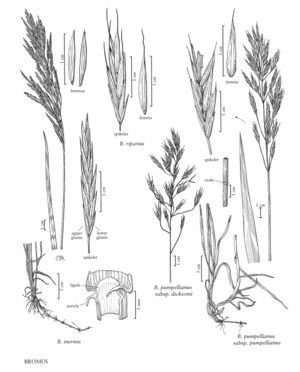Bromus pumpellianus subsp. pumpellianus
Plants rhizomatous. Culms 50-120 cm, erect; nodes 2-3 (4), usually pubescent, sometimes glabrous; internodes glabrous or pubescent. Sheaths pilose, villous, or glabrous; auricles present on the lower leaves or absent; ligules to 3 mm; blades 9-17 (25) cm long, (3) 4-8 (9) mm wide, abaxial surfaces glabrous or pilose, adaxial surfaces usually pilose, rarely glabrous. Panicles 10-20 cm, open or contracted, erect or nodding; branches erect to spreading. Spikelets 20-30 mm. Glumes glabrous, pubescent, or hirsute; lower glumes (4) 5-9 mm, 1-veined; upper glumes (5) 8-11 mm, 3-veined; lemmas 9-14 mm, pubescent on the lower portion of the back and along the margins; awns usually present, to 6 mm, sometimes absent; anthers 3.5-7 mm. 2n = 56.
Discussion
Bromus pumpellianus subsp. pumpellianus grows on sandy and gravelly stream banks and lake shores, sand dunes, meadows, dry grassy slopes, and road verges.
Selected References
None.
Lower Taxa
"decumbent" is not a number.
